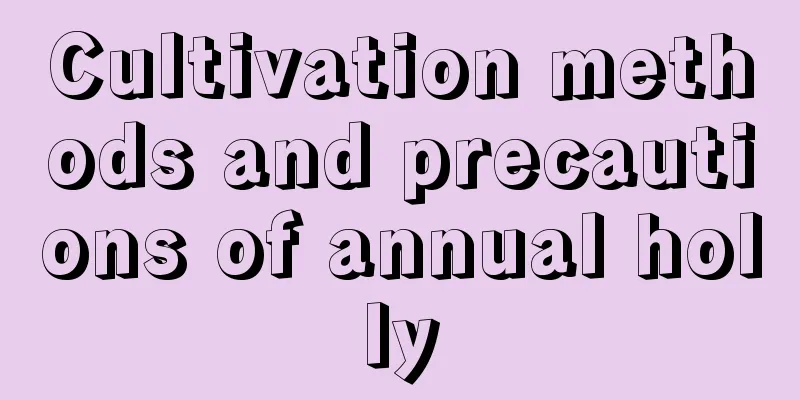Cultivation methods and precautions of annual holly

1. Maintenance methods1. Light management: During the maintenance process, you should try to give it sufficient sunlight, because it likes to grow in sunny places. 2. Substrate selection: Annual sedge is an annual or semi-annual herb with good growth ability, so it can grow in poor soil under harsh conditions. However, the soil should be fertile. 3. Nutrient management: Annual hollyhock has strong vitality and can adapt to harsh environments. It can grow normally if it is given the nutrients it needs. 4. Temperature management: This plant is not winter-resistant and the temperature needs to be kept at around 16-25 degrees Celsius all year round. Moreover, the temperature cannot change back and forth during the curing period. 2. Breeding techniques1. Summer: The temperature in summer needs to be maintained at 16-25 degrees Celsius. It needs to be cultivated outdoors, and it needs to be well ventilated and have sufficient water. 2. Reproduction: Annual fleabane reproduces by seeds, so it can be sown every year. The seeds germinate in early spring or autumn, the flowers bloom from June to August, and the fruits are produced from August to October. 3. Problem diagnosis and treatment1. Yellowing leaves: If yellowing leaves occur, it is most likely due to excessive fertilization or waterlogging. At this time, apply less fertilizer to avoid root burn, and check whether it is caused by waterlogging. If there is root rot, it should be pruned in time. 2. Root rot: When the rainy season comes in summer, waterlogging is likely to occur, leading to lack of oxygen at the roots and thus root rot. Waterproofing should be done in time, the soil should be loosened, and attention should be paid to ventilation. IV. Other issues1. Is it poisonous? Annual fleabane is a herbaceous plant. It is non-toxic and its beautiful flowers are very attractive. 2. Flowering time: The flowering time of annual fleabane is summer, that is, from June to September. Its flowering period is also very long, which is conducive to viewing. |
<<: Kudzu cultivation methods and precautions
>>: Cultivation methods and precautions of motherwort
Recommend
What are copper coin grass seeds like?
1. What are seeds like? Sowing is an important wa...
How to deal with the red flower jade after it blooms and how to keep it after it blooms
Treatment after the flowering of the red flower j...
What are the cultivation methods and precautions for potted osmanthus
Introduction to potted osmanthus Potted osmanthus...
Cultivation methods and precautions of azalea
1. Soil Rhododendrons prefer loose, fertile, slig...
Flower language of palace lantern lily
Flowering period of Lilium odoratum The flowering...
Common diseases and pests of ophiopogon and their control methods
Sclerotium rot Symptoms It often occurs in rainy ...
Diseases and pests of Rhododendron sabdariffa and their control methods
Pests of Rhododendron sabdariffa: Aphids symptom ...
Where is the best place to plant banyan trees? Is it best to plant them at the doorstep?
Banyan tree planting area Banyan tree is a tall t...
How to plant Magnolia grandiflora
1. Selecting seedlings When planting Magnolia gra...
Why do banyan leaves fall off when touched?
1. Long-term water shortage Reason: If the plant ...
What are the common diseases and pests of elderberry?
Common elderberry pests and diseases Let’s first ...
How to repot orchids: What time and soil are best for growing them?
1. Methods 1. It is best to change the pot on a s...
Give the flowers some beauty medicine, so that their leaves won’t turn yellow and their roots won’t rot, and they will bloom continuously in autumn and winter!
Feed the flowers some Chinese medicine, and their...
Plastic bags and bottles are so convenient and effective for growing flowers. I really regret throwing them away.
The use of plastic bags for growing flowers Huahu...
How to prune the iris
How to prune the iris Pruning during the breeding...









